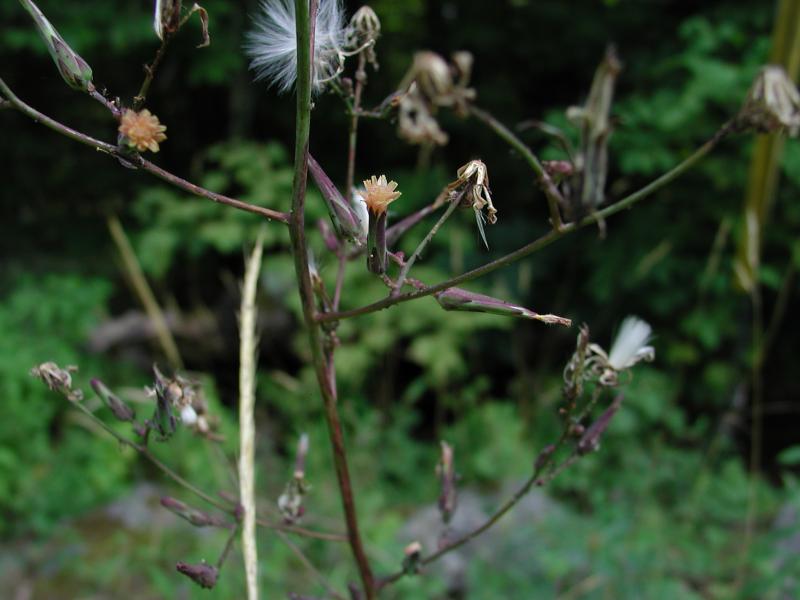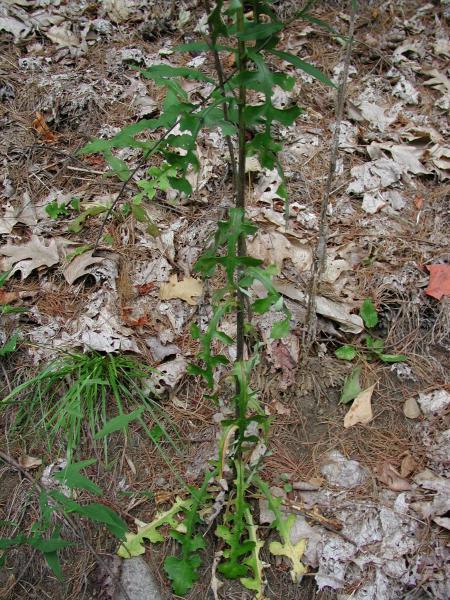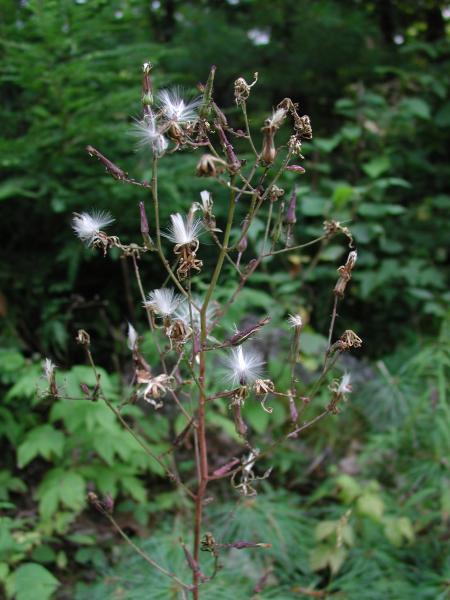Tall Hairy Lettuce
Lactuca hirsuta Muhl. ex Nutt.
- Class
- Dicotyledoneae (Dicots)
- Family
- Asteraceae (Aster Family)
- State Protection
- Endangered
Listed as Endangered by New York State: in imminent danger of extirpation in New York. For animals, taking, importation, transportation, or possession is prohibited, except under license or permit. For plants, removal or damage without the consent of the landowner is prohibited.
- Federal Protection
- Not Listed
- State Conservation Status Rank
- S1
Critically Imperiled in New York - Especially vulnerable to disappearing from New York due to extreme rarity or other factors; typically 5 or fewer populations or locations in New York, very few individuals, very restricted range, very few remaining acres (or miles of stream), and/or very steep declines.
- Global Conservation Status Rank
- G5?
Secure globally (most likely) - Conservation status is uncertain, but most likely common in the world; widespread and abundant (but may be rare in some parts of its range). More information is needed to assign a firm conservation status.
Summary
Did you know?
Unfortunately this beautiful Lactuca has been omitted from many of our popular wildflower guides (except for Peterson's Guide) so it probably goes unnoticed. There is one identification tip that is not in field guides and can be seen from a distance. It is the way the inflorescence branches are more open with longer secondary branches that often point in different directions. The common Lactuca biennis or L. canadensis have more compact inflorescences with many more flower heads in them.
State Ranking Justification
There are 5 verified occurrences, and 20 remaining historical sites to check, but populations have been extirpated from 5 sites by development.
Short-term Trends
The short term trend is unknown as only two confirmed extant sites have count data. At the site with a larger poopulation and a number of revisits the numbers flucuated over a 10 year period ranging from 120 to 60 and back to 135 ramets. Overall, the documented populations have generally been small with numbers ranging from 1 to 135 plants. Typical numbers have been 20 or fewer plants. Only four populations have been confirrmed since 2005.
Long-term Trends
The long term trend appears to be a significant decline. Out of 30 originally documented populations 5 have been extirpated, 6 additional populations have not be relocated during revisits since the 1990's. Of the original 30 sites 17 have only been visited once and 15 of these were documented in the 1950's or earlier. Due to the short lifespan of this plant revisits are needed at all sites to confirm the long-term trend of this species.
Conservation and Management
Threats
Intensive road-right of way and road maintainance activities may threaten this species including regularly being run over, covered up or mowed during the growing season. Destruction of the plants and habitat loss from sand mining is also a threat. The application of herbicides immediately following timber harvests on occupied sites could also be a threat.
Conservation Strategies and Management Practices
This is short-lived, apparently early successional species, management activities such as periodic prescribed burning, spring or fall mowing or brush cutting may facilitate maintanence of favorable site conditions. Avoid the application of herbicides to occupied sites or within a distance where non-target drift could occur. Avoid covering or driving over plants with equipment or vehicles during the growing season or for prolonged or ongoing periods. Protect plants from destruction at sites with active sand mining.
Research Needs
Due to the short life span of individual plants, studies are needed to understand the length of viability and persistence of Lactuca hirsuta's seed in the seedbank and the associated population dynamics of this species.
Habitat
Habitat
In New York Lactuca hirsuta has been found at open, sandy sites both natural (dry woods, inland dunes, and sand plains) and artificial (sandpits and roadsides) (New York Natural Heritage Program 2010). Openings in woods (FNA 2006). Dry open woods and clearings (Gleason and Cronquist 1991, Fernald 1970).
Associated Ecological Communities
- Pitch pine-scrub oak barrens
(guide)
A shrub-savanna community that occurs on well-drained, sandy soils that have developed on sand dunes, glacial till, and outwash plains.
- Roadcut cliff/slope
A sparsely vegetated cliff or steep slope, along a road, that was created by blasting or digging during road construction.
- Sand mine
An excavation in a sand deposit or sand dune from which sand has been removed. Vegetation is usually sparse.
- Successional northern sandplain grassland*
(guide)
A meadow community that occurs on open sandplains that have been cleared and plowed (for farming or development), and then abandoned. This community is usually dominated by low, dry turf of sedges and grasses less than 30 cm (12 inches) tall, and include patches of open sand and patches of soil covered with mosses and lichens.
* probable association but not confirmed.
Associated Species
- Acer pensylvanicum (striped maple)
- Acer saccharum (sugar maple)
- Ageratina altissima
- Aletris farinosa (white colicroot, unicorn-root)
- Andropogon virginicus
- Betula populifolia (gray birch)
- Botrychium sp.
- Carex swanii (Swan's sedge)
- Danthonia spicata (poverty grass)
- Daucus carota (wild carrot)
- Dichanthelium depauperatum (poverty rosette grass)
- Equisetum hyemale
- Euthamia graminifolia (common flat-topped-goldenrod)
- Fagus grandifolia (American beech)
- Festuca sp.
- Fragaria virginiana
- Helianthus strumosus (rough sunflower)
- Hieracium scabrum (sticky hawkweed)
- Juniperus communis
- Malaxis unifolia (green adder's-mouth)
- Oenothera biennis (common evening-primrose)
- Pinus strobus (white pine)
- Plantago major (common plantain)
- Pteridium aquilinum
- Rubus sp.
- Smilax herbacea (common carrion-flower)
- Solidago caesia
- Solidago juncea (early goldenrod)
- Trifolium aureum (large hop clover)
- Tsuga canadensis (eastern hemlock)
- Vaccinium angustifolium (common lowbush blueberry)
- Verbascum thapsus (common mullein)
Range
New York State Distribution
Lactuca hirsuta has been found throughout New York state.
Global Distribution
Lactuca hirsuta ranges from Prince Edward Island west to Ontario and south and west through Maine to Michigan, Illinois and southwest to Oklahoma and Texas, and south and east to Georgia.
Identification Comments
Identifying Characteristics
Lactuca hirsuta is an erect, branching, biennial herbaceous plant with a taproot it is typically one stemmed, and bears milky juice. During its first year it only forms basal rosettes, during its second year it grows up to 1.2 meters but is generally 80 cm or less tall. The leaves are alternate, rarerly prickly, chiefly limited to the lower (proximal) 1/3-2/3 of each stem, and have margins that are entire or with very fine teeth (denticulate) and midribs that are usually bristly-hairy. Florets are yellow (sometimes drying bluish) with purplish to greenish whorled bracts (involucres) 12-20 mm long. They are borne in more or less flat-topped (corymbiform), or tall pointed topped arrays with progressively shorter branches (paniculiform) towards the top of the plant. The fruit are dry, one-seeded cypselae with one prominent nerve and do not split at maturity, the body and beak have a combined length of 7 to 10 mm.The length of the hairs (pappi) forming a tuft at the tip of the fruit is 8-12 mm long.
Best Life Stage for Proper Identification
Fruiting individuals are best for identification. Plants with stem, leaves and intact mature fruit are needed for positive identification.
Similar Species
Lactuca canadensis is somewhat similar in appearance to L. hirsuta, but can be distinguished by its smaller flower heads, also in fruit the whorl of bracts surrounding the base of the florets (involucre) are 10 to 15 mm vs. 15 to 22 mm long. The fruits (cypselae) of these species differ in size, the body and beak of L. canadensis' have a combined length of 5 to 6 mm while it is 7 to 9mm for L. hirsuta. The length of the hairs (pappi) forming a tuft at the tip of the fruit also separate the two, with a length of 5 to 7 mm for L. candensis and 8 to 12 mm on L. hirsuta.
Best Time to See
Lactuca hirsuta typically flowers from early July through August, with mature fruits developing July through October.
- Flowering
- Fruiting
The time of year you would expect to find Tall Hairy Lettuce flowering and fruiting in New York.
Tall Hairy Lettuce Images
Taxonomy
Tall Hairy Lettuce
Lactuca hirsuta Muhl. ex Nutt.
- Kingdom Plantae
- Phylum Anthophyta
- Class Dicotyledoneae
(Dicots)
- Order Asterales
- Family Asteraceae (Aster Family)
- Order Asterales
- Class Dicotyledoneae
(Dicots)
- Phylum Anthophyta
Additional Common Names
- Downy Lettuce
Synonyms
- Lactuca hirsuta var. sanguinea (Bigelow) Fern.
Additional Resources
Best Identification Reference
Strother, J. L. 2006. Lactuca L. Pages 259-263 in: Flora of North America Committee (Editors). 2006. Flora of North America North of Mexico. Vol. 19. Magnoliophyta: Asteridae, part 6: Asteraceae, part 1. Oxford Univ. Press, New York. xxiv + 579 pp.
Other References
Fernald, M.L. 1950. Gray's manual of botany. 8th edition. D. Van Nostrand, New York. 1632 pp.
Gleason, Henry A. and A. Cronquist. 1991. Manual of Vascular Plants of Northeastern United States and Adjacent Canada. The New York Botanical Garden, Bronx, New York. 910 pp.
Holmgren, Noel. 1998. The Illustrated Companion to Gleason and Cronquist's Manual. Illustrations of the Vascular Plants of Northeastern United States and Adjacent Canada. The New York Botanical Garden, Bronx, New York.
Mitchell, Richard S. and Gordon C. Tucker. 1997. Revised Checklist of New York State Plants. Contributions to a Flora of New York State. Checklist IV. Bulletin No. 490. New York State Museum. Albany, NY. 400 pp.
New York Natural Heritage Program. 2024. New York Natural Heritage Program Databases. Albany, NY.
Reschke, Carol. 1990. Ecological communities of New York State. New York Natural Heritage Program, New York State Department of Environmental Conservation. Latham, NY. 96 pp. plus xi.
Weldy, T. and D. Werier. 2010. New York flora atlas. [S.M. Landry, K.N. Campbell, and L.D. Mabe (original application development), Florida Center for Community Design and Research http://www.fccdr.usf.edu/. University of South Florida http://www.usf.edu/]. New York Flora Association http://newyork.plantatlas.usf.edu/, Albany, New York
Links
About This Guide
Information for this guide was last updated on: April 18, 2019
Please cite this page as:
New York Natural Heritage Program. 2024.
Online Conservation Guide for
Lactuca hirsuta.
Available from: https://guides.nynhp.org/downy-lettuce/.
Accessed July 26, 2024.


